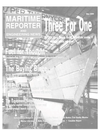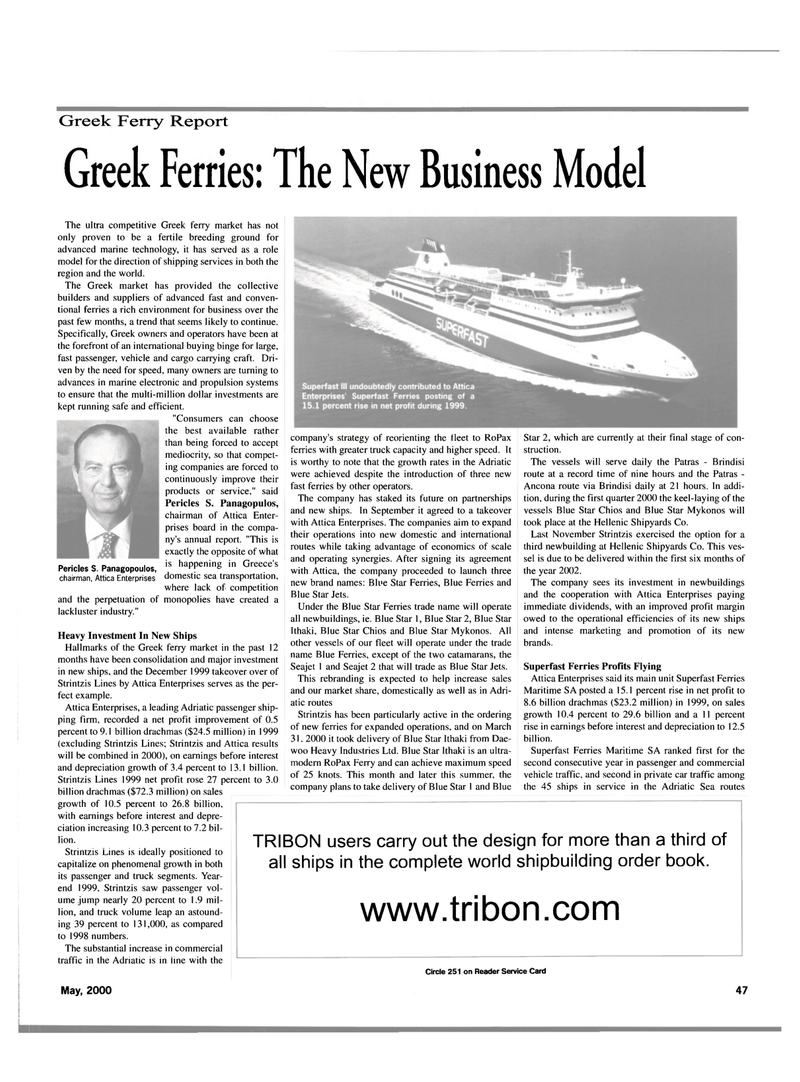
Page 49: of Maritime Reporter Magazine (May 2000)
Read this page in Pdf, Flash or Html5 edition of May 2000 Maritime Reporter Magazine
Greek Ferry Report
Greek Ferries: The New Business Model
Pericles S. Panagopoulos, chairman, Attica Enterprises
The ultra competitive Greek ferry market has not only proven to be a fertile breeding ground for advanced marine technology, it has served as a role model for the direction of shipping services in both the region and the world.
The Greek market has provided the collective builders and suppliers of advanced fast and conven- tional ferries a rich environment for business over the past few months, a trend that seems likely to continue.
Specifically, Greek owners and operators have been at the forefront of an international buying binge for large, fast passenger, vehicle and cargo carrying craft. Dri- ven by the need for speed, many owners are turning to advances in marine electronic and propulsion systems to ensure that the multi-million dollar investments are kept running safe and efficient. "Consumers can choose the best available rather than being forced to accept mediocrity, so that compet- ing companies are forced to continuously improve their products or service," said
Pericles S. Panagopulos, chairman of Attica Enter- prises board in the compa- ny's annual report. "This is exactly the opposite of what is happening in Greece's domestic sea transportation, where lack of competition and the perpetuation of monopolies have created a lackluster industry."
Heavy Investment In New Ships
Hallmarks of the Greek ferry market in the past 12 months have been consolidation and major investment in new ships, and the December 1999 takeover over of
Strintzis Lines by Attica Enterprises serves as the per- fect example.
Attica Enterprises, a leading Adriatic passenger ship- ping firm, recorded a net profit improvement of 0.5 percent to 9.1 billion drachmas ($24.5 million) in 1999 (excluding Strintzis Lines; Strintzis and Attica results will be combined in 2000), on earnings before interest and depreciation growth of 3.4 percent to 13.1 billion.
Strintzis Lines 1999 net profit rose 27 percent to 3.0 billion drachmas ($72.3 million) on sales growth of 10.5 percent to 26.8 billion, with earnings before interest and depre- ciation increasing 10.3 percent to 7.2 bil- lion.
Strintzis Lines is ideally positioned to capitalize on phenomenal growth in both its passenger and truck segments. Year- end 1999, Strintzis saw passenger vol- ume jump nearly 20 percent to 1.9 mil- lion, and truck volume leap an astound- ing 39 percent to 131,000, as compared to 1998 numbers.
The substantial increase in commercial traffic in the Adriatic is in line with the company's strategy of reorienting the fleet to RoPax ferries with greater truck capacity and higher speed. It is worthy to note that the growth rates in the Adriatic were achieved despite the introduction of three new fast ferries by other operators.
The company has staked its future on partnerships and new ships. In September it agreed to a takeover with Attica Enterprises. The companies aim to expand their operations into new domestic and international routes while taking advantage of economics of scale and operating synergies. After signing its agreement with Attica, the company proceeded to launch three new brand names: Blue Star Ferries, Blue Ferries and
Blue Star Jets.
Under the Blue Star Ferries trade name will operate all newbuildings, ie. Blue Star 1, Blue Star 2, Blue Star
Ithaki, Blue Star Chios and Blue Star Mykonos. All other vessels of our fleet will operate under the trade name Blue Ferries, except of the two catamarans, the
Seajet 1 and Seajet 2 that will trade as Blue Star Jets.
This rebranding is expected to help increase sales and our market share, domestically as well as in Adri- atic routes
Strintzis has been particularly active in the ordering of new ferries for expanded operations, and on March 31. 2000 it took delivery of Blue Star Ithaki from Dae- woo Heavy Industries Ltd. Blue Star Ithaki is an ultra- modern RoPax Ferry and can achieve maximum speed of 25 knots. This month and later this summer, the company plans to take delivery of Blue Star 1 and Blue
Star 2, which are currently at their final stage of con- struction.
The vessels will serve daily the Patras - Brindisi route at a record time of nine hours and the Patras -
Ancona route via Brindisi daily at 21 hours. In addi- tion, during the first quarter 2000 the keel-laying of the vessels Blue Star Chios and Blue Star Mykonos will took place at the Hellenic Shipyards Co.
Last November Strintzis exercised the option for a third newbuilding at Hellenic Shipyards Co. This ves- sel is due to be delivered within the first six months of the year 2002.
The company sees its investment in newbuildings and the cooperation with Attica Enterprises paying immediate dividends, with an improved profit margin owed to the operational efficiencies of its new ships and intense marketing and promotion of its new brands.
Superfast Ferries Profits Flying
Attica Enterprises said its main unit Superfast Ferries
Maritime SA posted a 15.1 percent rise in net profit to 8.6 billion drachmas ($23.2 million) in 1999, on sales growth 10.4 percent to 29.6 billion and a 11 percent rise in earnings before interest and depreciation to 12.5 billion.
Superfast Ferries Maritime SA ranked first for the second consecutive year in passenger and commercial vehicle traffic, and second in private car traffic among the 45 ships in service in the Adriatic Sea routes
TRIBON users carry out the design for more than a third of all ships in the complete world shipbuilding order book. www.tribon.com
Circle 251 on Reader Service Card
May, 2000 47

 48
48

 50
50
